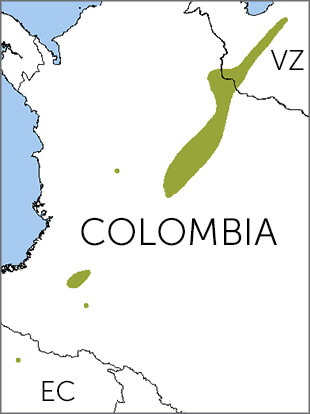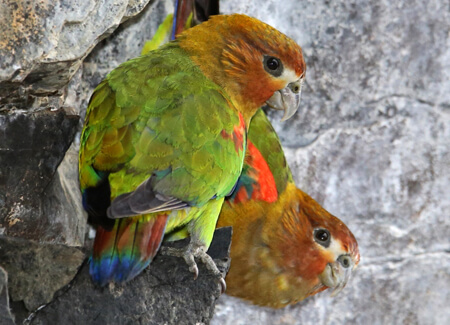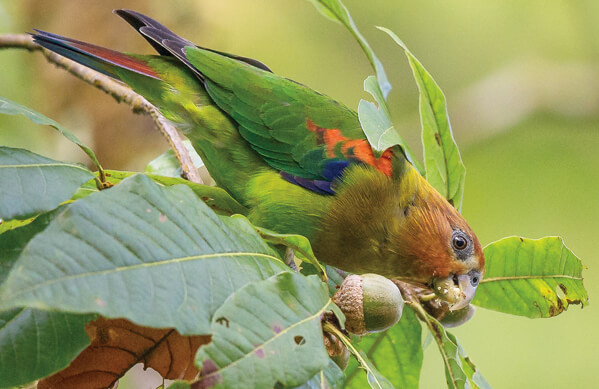 Like others of their tribe, Rusty-faced Parrots are social, noisy birds traveling in pairs or flocks of up to 25 individuals. But these birds — found in the Andes Mountains in Colombia and Venezuela — also spend a lot of quiet time, foraging in the forest canopy or lower down in small fruiting trees or even shrubs, combing the branches for fruit, blossoms, and seeds.
Like others of their tribe, Rusty-faced Parrots are social, noisy birds traveling in pairs or flocks of up to 25 individuals. But these birds — found in the Andes Mountains in Colombia and Venezuela — also spend a lot of quiet time, foraging in the forest canopy or lower down in small fruiting trees or even shrubs, combing the branches for fruit, blossoms, and seeds.
Eating and Drinking, Parrot Style
Within the Rusty-faced Parrot's cloud forest habitat, bromeliads abound on the mossy tree boughs. The birds visit to drink rain water collected in the epiphytic plants' hollow centers.
They also frequent exposed outcroppings known as clay licks, where they consume clay and dirt that contain essential nutrients. Scientists aren't entirely sure which nutrients are essential to parrots visiting clay licks, but some believe sodium may be what they're after. Others suggest that clay and dirt help neutralize toxins the birds ingest, such as tannins accumulated after eating certain fruits and seeds.
Living the High Life
Rusty-faced Parrots are found in upper-elevation subtropical forests and montane cloud forests in the northern Andes, almost up to the cold, open páramo. Their misty, frequently rainy habitat occurs from an elevation a bit higher than Denver, CO (5,400 feet) up to almost twice that high – 10,650 feet.
(Audio by Hans Matheve, XC202950. Accessible at www.xeno-canto.org/202950)
The Rusty-faced Parrot belongs to the genus Hapalopsittaca, which includes four species, all of them Andean. The closely related Red-faced Parrot and the Fuertes' Parrot were once considered subspecies of the Rusty-faced Parrot.
More Than Just a Rusty Face
This range-restricted species is separated into three distinct subspecies, each with its own isolated range in the Andes of Colombia and Venezuela. There is at least one sight record from northern Ecuador as well. The most obvious difference between the subspecies is in head and breast color, which ranges from dull orange-rust in two subspecies to peach in the most colorful one.
Although predominantly green, all Rusty-faced Parrots sport accents in a rainbow of colors. They show yellow on the lores (between eye and bill), blue covering the underwings and splashed a bit near the shoulders, red on much of the tail except for the violet tip — and a brighter scarlet on the shoulder patches, which flash in flight.
Sign up for ABC's eNews to learn how you can help protect birds
Puzzling Parrots
Habitat loss is the greatest threat to this species. Its cloud forest habitat is threatened by logging and clearing for agriculture (particularly unsustainable cattle ranching), infrastructure development, and mining.
This parrot's natural history remains poorly known, inhibiting actions that could help better conserve the bird. For example, roosting flocks of up to 250 Rusty-faced Parrots have been observed in secondary forest and plantations of alder, a fast-growing tree grown for timber. The parrots have also been reported from wooded pastures, but it's not known whether these altered habitats offer feeding and nesting opportunities. Fortunately, as it becomes safer to travel in the Andes of Colombia, more people are able to see and study these rare birds.

Rusty-faced Parrots by Tom Friedel/BirdPhotos.com
Creating a Safe Harbor
Not long ago, the Rusty-faced Parrot was considered rare throughout its range. The International Union for the Conservation of Nature (IUCN) gave it Endangered status. But in 2005, after the species was found to be fairly common in several areas, IUCN changed the bird's status to Vulnerable, citing habitat loss as a continuing danger within its disjunct, localized range.
The Rusty-faced Parrot has been recorded in more than a dozen protected areas (both national and private) in Colombia. One of these is the Colibrí del Sol Bird Reserve, established in 2005 by ABC and its Colombian partner Fundación ProAves. Other species protected here include the Critically Endangered Glittering Starfrontlet hummingbird, the Endangered Chestnut-bellied Flowerpiercer, and the Critically Endangered Urrao, or Fenwick's, Antpitta. Most of this rare antpitta's known range falls within the reserve.
More Places to Nest
Availability of naturally formed or woodpecker-excavated nest cavities can be a limiting factor for parrots. Since 2012, a Rusty-faced Parrot nest box program has been successful in the Colibrí del Sol Bird Reserve, augmenting nesting possibilities for the birds, thanks to support provided to ProAves from Loro Parque Fundación and ABC.
The Rusty-faced Parrot joins an impressive list of rare parrots now using nest boxes in the wild, including the Blue-throated Macaw (Bolivia), Gray-breasted Parakeet (Brazil), Yellow-eared Parrot (Colombia), El Oro Parakeet (Ecuador), and Golden-plumed Parakeet (Colombia, Ecuador, and Peru). Many of these projects are supported by ABC.
Donate to support ABC's conservation mission!



















































